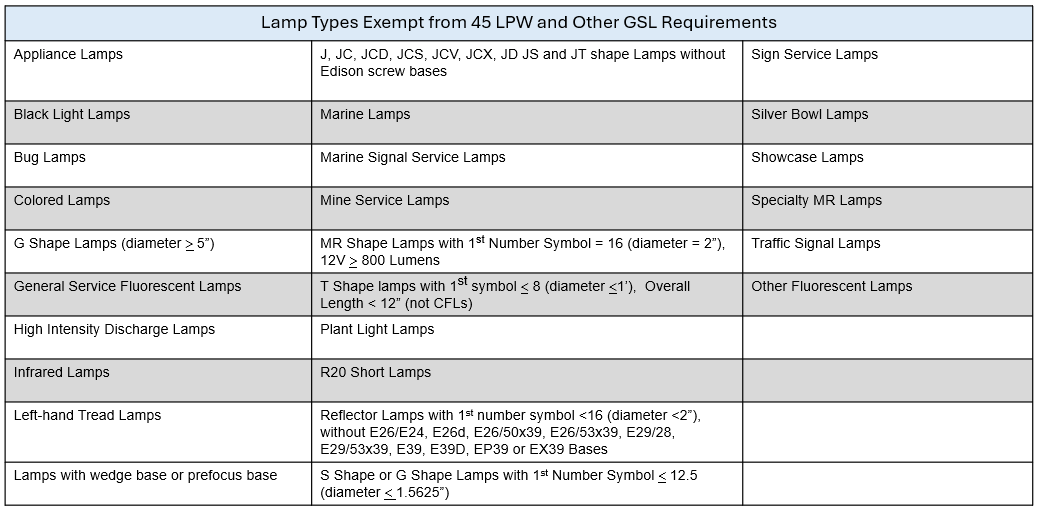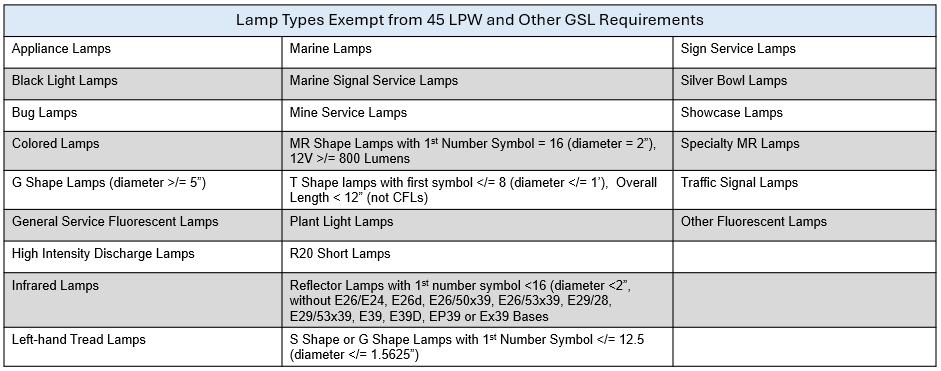Halco's California Title 20 Information and Q&A
California’s Energy Efficiency Standards
TITLE 24 VS TITLE 20:
- Title 24 deals with the way a building is set up and controlled
- Title 20 is a product-specific standard
- A product that meets Title 20 does not automatically mean it meets Title 24
3 MAIN CATEGORIES OF LAMPS ARE REGULATED BY THE STATE OF CALIFORNIA UNDER TITLE 20:
- GENERAL SERVICE LAMPS (GSLs)
- STATE-REGULATED LED LAMPS (SLEDs)
- STATE-REGULATED SMALL DIAMETER DIRECTIONAL LAMPS (SDDLs)
GENERAL SERVICE LAMPS (GSLs):
- INC, CFL, LED, Halogen, OLED lamps with ANSI or E26 base and intended for general service applications
- Output ≥ 310lm, ≤ 3,300lm
STATE-REGULATED LED LAMPS (SLEDs):
- LED lamps with E12, E17, E26, GU24 base (only these bases)
- Includes downlight retrofits with bases above
- Output ≤ 2600lm
- CCT = 2200K to 7000K
STATE-REGULATED SMALL DIAMETER DIRECTIONAL LAMPS (SDDLs):
- 12V, 24V, 120V INC, CFL, LED lamps with Dia. ≤ 2.25”
- ANSI Pin Base or E26 Base
- Output ≤ 850lm or Wattage ≤ 75W; and Rated Life > 300hrs
TITLE 20 GENERAL REQUIREMENTS:
- Color Rendering Index (CRI) of ≥ 82
- Lumens per Watt (LPW)
- ≥ 45 for GSLs
- ≥ 80 for SLED or SDDL
- Power Factor ≥ 0.7
- Service life
- ≥ 10,000 for LED lamps
- ≥ 25,000 for directional lamps
MAEDBS (MODERNIZED APPLIANCE EFFICIENCY DATABASE SYSTEM)
- To be legally sold in California, all GSLs, SLEDs, and SDDLs are required to pass testing and performance requirements to be certified and registered in the CEC database
FOUR VIOLATIONS UNDER TITLE 20:
- Failure to certify
- Does not meet standard
- Failure to mark
- Providing false information
California Title 20 Question & Answers
What lighting products are subject to Title 20?
FEDERALLY AND CALIFORNIA REGULATED
- Fluorescent Lamp Ballasts
- General Service Fluorescent Lamps
-
Incandescent Reflector Lamps
- General Service Incandescent Lamps & Modified Spectrum General Service Incandescent Lamps
- Candelabra and Intermediate Base Incandescent Lamps
- E26 Base CFLs
- Torchieres
- Metal Halide Lamp Fixtures
- Emergency Lighting and Self-Contained Lighting Controls
- Traffic Signal Modules and Traffic Signal Lamps
ONLY CALIFORNIA REGULATED
- Illuminated Exit Signs
- GU-24 Base Lamps
- GU-24 Adaptors
- Self-Contained Lighting Controls
- Metal Halide Luminaires
- Under-Cabinet Luminaires (commercial office only)
- State-Regulated Incandescent Reflector Lamps
- State-Regulated General Service Incandescent Lamps
- Modified Spectrum Incandescent Lamps
To be legally sold in CA,all products in both lists shown are required to pass testing and performance requirements to be certified and registered in the CEC database - MAEDBS (Modernized Appliance Efficiency Database System)
What is the definition (scope) of a GSL?
- INC, CFL, LED, Halogen, OLED (all technologies) lamps with ANSI or E26 base and intended for general service applications
- Able to operate at 12V, 24V, at or between 100V to 130V, at or between 220V to 240V (or 277V for integrated lamps)
- Output ≥ 310lm, ≤ 3,300lm (or output ≥ 232lm, ≤ 1,950lm for modified spectrum)
-
- Includes most CFLs and INC omnidirectional E26 base lamps
- Does not include light fixtures or LED downlight retrofit kits
- Does not include INC reflector lamps, fluorescent tubes
What are the minimum GSL requirements?


What products are exempt from 45 LPW and other GSL requirements?
- Lamps without ANSI or E26 base, output <310lm or > 3,300lm
- Other general lighting application lamp types:


Note: Some of these lamps are still regulated under one of the other two state regulations: LED Lamps, SDDLs
What are some GSL exemptions that don’t apply in California?
- Vibration service lamps
- Incandescent reflector lamps
- 3-way incandescent lamps
- Shatter-resistant lamps
- Rough service lamps
- E12 & E17 bases
- T shape lamps (≤ 40W or length> 10”)
- B, BA, CA, F, G16 ½, G-25, G30, S, M-14 lamps of ≤40W
What is the definition (scope) of a SLED?
- LED lamps with E12, E17, E26, GU24 base (only these bases)
- Output ≤ 2600lm
- Includes downlight retrofits with bases above
- Capable of producing white light with:
- CCT = 2200K to 7000K
- Deep Ultraviolet (Duv) between -0.012 and 0.012
What are the minimum SLED requirements?
- Output ≥ 150lm (E12 base) or ≥ 200lm (E17, E26 and GU24 bases)
- R1 through R8 values ≥ 72
- PF ≥ 0.7
- ENERGY STAR ® V2.0 omnidirectional lamps (A-lamps)
- ENERGY STAR ® V1.1 decorative lamps (B, BA, C, CA, F, or G)
- Dimmable lamps: Dimmable to 10%, reduce flicker, noise less than 24 dB at 100% and 20%
- Compliance Score = Efficacy + (2.3 * CRI)


Example:
68 LPW + (2.3 x 90 CRI) => 275 compliance score FAIL
75 LPW + (2.3 x 90 CRI) => 282 compliance score PASS
What LED products are outside the scope of the Title 20 regulations?
- LED Tubes
- LED plug-ins (non-directional CFL pin base replacements)
- LED HID replacements
What is the definition (scope) of a SDDL?
- INC, CFL, LED, Halogen lamps with ANSI Pin Base or E26 Base
- Able to operate at 12V, 24V, or 120V
- Non-tubular directional lamps with Dia. ≤ 2.25”
- Output ≤ 850lm or Wattage ≤ 75W
- Rated Life > 300hrs
- Typically found in retail, hospitality, and museum track lighting
- Examples of Small Diameter ANSI pin base lamps include MR16 lamps with GU10 base (120V) and GU5.3 (12V)
Note: State-regulated small diameter directional lamps do not include directional lamps with an E26 base that utilize LEDs and are covered under the definition of state-regulated LED lamps
What are the minimum SDDL requirements?
- Requirements applicable to all INC, CFL, LED, and Halogen lamps
- Compliance Score = Efficacy + CRI


Example:
70 LPW + 90 CRI=> 160 compliance score FAIL
75 LPW + 90 CRI => 165 compliance score PASS
Note: These requirements will eliminate most INC and Halogen MR11, MR16, GU10, R/PAR16 lamps sold in CA in favor of LED
What is the definition (scope) of an illuminated exit sign?
- Permanently fixed sign to identify an exit
- Contains electrically powered integral light source that illuminates the legend “EXIT” and directional indicators
- Provides contrast between the legend, directional indicators, and the background
- Input power demand is the amount of power, in watts, required to illuminate an exit sign continuously
- Face is the illuminated side(s) of an exit sign
What are the minimum illuminated exit sign requirements?


California Title 20 Question & Answers
What lighting products are subject to Title 20?
FEDERALLY AND CALIFORNIA REGULATED
- Fluorescent Lamp Ballasts
- General Service Fluorescent Lamps
- Incandescent Reflector Lamps
- General Service Incandescent Lamps & Modified Spectrum General Service Incandescent Lamps
- Candelabra and Intermediate Base Incandescent Lamps
- E26 Base CFLs
- Torchieres
- Metal Halide Lamp Fixtures
- Emergency Lighting and Self-Contained Lighting Controls
- Traffic Signal Modules and Traffic Signal Lamps
ONYL CALIFORNIA REGULATED
- Illuminated Exit Signs
- GU-24 Base Lamps
- GU-24 Adaptors
- Self-Contained Lighting Controls
- Metal Halide Luminaires
- Under-Cabinet Luminaires (commercial office only)
- State-Regulated Incandescent Reflector Lamps
- State-Regulated General Service Incandescent Lamps
- Modified Spectrum Incandescent Lamps
To be legally sold in CA,all products in both lists shown are required to pass testing and performance requirements to be certified and registered in the CEC database - MAEDBS (Modernized Appliance Efficiency Database System)
What is the definition (scope) of a GSL?
- INC, CFL, LED, Halogen, OLED (all technologies) lamps with ANSI or E26 base and intended for general service applications
- Able to operate at 12V, 24V, at or between 100V to 130V, at or between 220V to 240V (or 277V for integrated lamps)
- Output ≥ 310lm, ≤ 3,300lm (or output ≥ 232lm, ≤ 1,950lm for modified spectrum)
- Includes most CFLs and INC omnidirectional E26 base lamps
- Does not include light fixtures or LED downlight retrofit kits
- Does not include INC reflector lamps, fluorescent tubes
What are the minimum GSL requirements?

What products are exempt from 45 LPW and other GSL requirements?
- Lamps without ANSI or E26 base, output <310lm or > 3,300lm
- Other general lighting application lamp types:

Note: Some of these lamps are still regulated under one of the other two state regulations: LED Lamps, SDDLs
What are some GSL exemptions that don’t apply in California?
- Vibration service lamps
- Incandescent reflector lamps
- 3-way incandescent lamps
- Shatter-resistant lamps
- Rough service lamps
- E12 & E17 bases
- T shape lamps (≤ 40W or length> 10”)
- B, BA, CA, F, G16 ½, G-25, G30, S, M-14 lamps of ≤40W
What is the definition (scope) of a SLED?
- LED lamps with E12, E17, E26, GU24 base (only these bases)
- Output ≤ 2600lm
- Includes downlight retrofits with bases above
- Capable of producing white light with:
- CCT = 2200K to 7000K
- Deep Ultraviolet (Duv) between -0.012 and 0.012
What are the minimum SLED requirements?
- Output ≥ 150lm (E12 base) or ≥ 200lm (E17, E26 and GU24 bases)
- R1 through R8 values ≥ 72
- PF ≥ 0.7
- ENERGY STAR ® V2.0 omnidirectional lamps (A-lamps)
- ENERGY STAR ® V1.1 decorative lamps (B, BA, C, CA, F, or G)
- Dimmable lamps: Dimmable to 10%, reduce flicker, noise less than 24 dB at 100% and 20%
- Compliance Score = Efficacy + (2.3 * CRI)

Example:
68 LPW + (2.3 x 90 CRI) => 275 compliance score FAIL
75 LPW + (2.3 x 90 CRI) => 282 compliance score PASS
- Output ≥ 150lm (E12 base) or ≥ 200lm (E17, E26 and GU24 bases)
What LED products are outside the scope of the Titel 20 regulations?
- LED Tubes
- LED plug-ins (non-directional CFL pin base replacements)
- LED HID replacements
What is the definition (scope) of a SDDL?
- INC, CFL, LED, Halogen lamps with ANSI Pin Base or E26 Base
- Able to operate at 12V, 24V, or 120V
- Non-tubular directional lamps with Dia. ≤ 2.25”
- Output ≤ 850lm or Wattage ≤ 75W
- Rated Life > 300hrs
- Typically found in retail, hospitality, and museum track lighting
- Examples of Small Diameter ANSI pin base lamps include MR16 lamps with GU10 base (120V) and GU5.3 (12V)
Note: State-regulated small diameter directional lamps do not include directional lamps with an E26 base that utilize LEDs and are covered under the definition of state-regulated LED lamps
What are the minimum SDDL requirements?
- Requirements applicable to all INC, CFL, LED, and Halogen lamps
- Compliance Score = Efficacy + CRI

Example:
70 LPW + 90 CRI=> 160 compliance score FAIL
75 LPW + 90 CRI => 165 compliance score PASS
Note: These requirements will eliminate most INC and Halogen MR11, MR16, GU10, R/PAR16 lamps sold in CA in favor of LED
What is the definition (scope) of an illuminated exit sign?
- Permanently fixed sign to identify an exit
- Contains electrically powered integral light source that illuminates the legend “EXIT” and directional indicators
- Provides contrast between the legend, directional indicators, and the background
- Input power demand is the amount of power, in watts, required to illuminate an exit sign continuously
- Face is the illuminated side(s) of an exit sign
- Permanently fixed sign to identify an exit
What are the minimum illuminated exit sign requirements?


